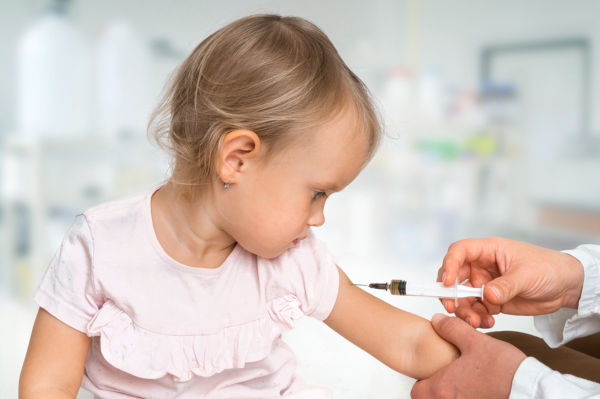Earlier this year, research by Unicef revealed that just over half a million children in the UK remained unvaccinated against MMR (Measles, Mumps, and Rubella), giving the UK the rank of third worst high income country for vaccination rates. The rates of children who have received the vaccination have fallen for four years in a row, and it’s thought to have been fuelled by conspiracy theories and fear mongering spread by social media sites, along with a handful of vocal celebrities.
The trend has alarmed experts who point out that in order to maintain “herd immunity”, a rate of 95% of children receiving the vaccination is required. It has led to the current health secretary, Matt Hancock, to state that he will not rule out “compulsory vaccination” and that he is willing to consider all options to ensure that children are kept safe.
What Is Herd Immunity & Why Is It Important?

Herd immunity is a fairly simple concept. Basically, the more people who are immune to a disease, such as measles, the less people there are who are able to spread the disease around. This means that those who are not immune to the disease are less like to catch it.
It’s important because in a country where vaccinations are readily available, those who do not have immunity are typically more vulnerable to complications from the disease. Someone who is suffering from an immune-suppressing disease, such as cancer, may have lost their protection from their childhood vaccinations and are therefore depending on herd immunity to keep them safe. If an immune-suppressed person catches a disease, such as measles, the chances of it having fatal consequences are considerably higher than that of a healthy person.
Some children have allergies that mean they are unable to receive vaccinations. They are also reliant on herd immunity, and many childhood diseases can have severe or fatal consequences in some patients.
If more and more parents choose not to vaccinate their healthy children, then that means that there are more people who are able to transmit these diseases, increasing the risk for vulnerable people. By choosing not to vaccinate, some parents are willingly risking the lives of others around them.
Vaccine Scare Stories – Common Myths Found On Social Media

Social media can be a fantastic resource, but sadly, it has some darker elements, and the anti-vaccination campaign is one area where social media has been a negative force.
Articles are regularly shared across social media decrying the use of vaccinations. They are often written by someone purporting to be a “health professional”, although dig a little deeper and you will often find that their qualification is a course in homeopathy at an online university with a questionable reputation. Furthermore, groups crop up on sites like Facebook that contain thousands of parents who have some concerns about vaccinations and in these groups a plethora of mis-information and poorly interpreted science is shared, creating scare-stories and an increase in anti-vaccination sentiment.
As a result, a number of myths concerning the safety of vaccinations have been spread around social media. Some have no basis in reality at all, whilst others are based on a small element of risk that is vastly outweighed by the risk of catching the disease itself.
1. Vaccines Cause Autism

This myth dates back to 1997, when Andrew Wakefield published a now widely debunked study that linked the MMR vaccination to autism. The study resulted in a dramatic drop in the number of parents who took up the vaccine for their children, and the idea that vaccines cause autism can still be found in social media forums today, over twenty years later.
In the years that followed Wakefied’s publication, further studies were unable to recreate his findings. It was later discovered that Wakefield was set to benefit financially from the scare, by launching a new venture that would offer autism testing with a view to supporting parents to pursue litigation. Further investigation into the way Wakefield conducted his research led to the paper being retracted from the journal in which it was published and Wakefield was struck off the UK medical registrar. In a tribunal by the General Medical Council in 2010, Wakefield was charged with abusing developmentally delayed children via his research.
Since the now debunked report was published, there have been numerous further studies into the issue, and none have found a link between the MMR vaccine and autism. In fact, earlier this year, findings of a Danish study that took over a decade to complete and studied more than 650,000 babies found that there was no increased risk of autism after the MMR vaccine, even in children who were already at risk of the disease due to having an older sibling with an autism diagnosis. Crucially, the report found that the rates of autism remained the same between children who were vaccinated and children who were not.
Unfortunately, autism symptoms tend to present around the same time that the MMR vaccine is administered at aged 12 months, as this is when developmental delays become more apparent. It’s therefore understandable that parents may have concerns, but as the science shows, there simply is no link between vaccines and autism.
2. Vaccines Contain Dangerous Chemicals Such as Mercury, Formaldehyde, and Aluminium. We Have No Way Of Knowing What The Full List Of Vaccine Ingredients Includes

Thiomersal is a compound of mercury that was once used as a preservative in vaccinations. It has antiseptic properties and prevented the growth of bacteria in vaccinations. Although there is no evidence that the use of thiomersal in vaccinations can have adverse affects, the use of the preservative in vaccinations in the UK ceased around twenty years ago. Today’s vaccines do not contain thiomersal.
Formaldehyde is a naturally occurring gas that is used to create resins that are used around the world to create various products, including plywood, insulation materials, carpets, cosmetics, and engine components. It can also be dissolved and used a disinfectant. In the UK, formaldehyde is used in the manufacturing process of vaccinations to remove toxins from bacteria that are then used to create a vaccine. Although this chemical can be harmful in large doses, there are trace amounts left in a vaccine and, in fact, the chemical is produced naturally in your own bloodstream in much greater quantities.
Aluminium is present in vaccines in trace amounts in the form of aluminium hydroxide. It is used as an adjuvant, which is a substance that enhances the body’s immune response to the vaccine, meaning that less doses of the vaccines are necessary to make it effective. Like many substances, including even water, aluminium can be toxic if you ingest enough of it. However, the amount present in a vaccination is so small, it is not significant, and there is no evidence to suggest that the amount of aluminium in a vaccine is harmful. In fact, aluminium is such a common element on the earth that is almost everywhere, including in the air we breathe and the food we eat. By the time your baby is six months old, he or she would have inhaled more aluminium, and ingested more aluminium through breast or formula milk than they would have received from vaccinations.
It is simply not the case that we can not know what is being put into vaccines. A patient leaflet is provided with all vaccines that has a full list of the ingredients used during the manufacturing process, and you can ask your health professional for a copy when your child receives the vaccine.
3. Separate Vaccines Are Healthier – Too Many Vaccines At Once Can Overload The Body

From the moment your child was born, they came into contact with thousands of bacteria. Bacteria are in the air, in our water, in our food, on our hands. They are everywhere. Your child’s body is an amazing thing, in that it is capable of fighting of these thousands of bacteria every day through its immune system. The bacteria and viruses that are present in vaccines are highly weakened, designed to be just enough for your body to learn how to recognise and defeat them, so that later on, when you encounter such bacteria “in the wild”, your body will be ready to fight. Before your child has their first vaccinations at 8 weeks, they have already encountered bacteria and viruses that are far more numerous and stronger than those found in a vaccine, and the chances are, they have coped just fine.
Studies have shown that vaccines do not weaken the body’s immune system in any way, and that even if a child has 11 vaccines at once, it would only use 0.1% of the body’s immune system. Furthermore, the vaccine schedule has been designed to given at an optimal time, when your child is most vulnerable to these diseases and the vaccines are most likely to be effective. There is no reason to space out vaccinations – it is a pointless and costly exercise that benefits no one.
4. The Rubella Vaccine Only Benefits Pregnant Women And They Can Just Get The Vaccination When Needed

It is true that Rubella, also known as German Measles, is very serious if contracted by a pregnant woman, since it often causes miscarriage or stillbirth. For babies that survive their mother’s infection with Rubella, there is a very high risk of heart defects, blindness, deafness, and other organ problems. It is also true that the vaccine was developed primarily to protect pregnant women.
However, Rubella is not without possible serious complications for those who contract it and are not pregnant. Rubella can cause brain inflammation and lead to secondary infections, such as pneumonia and bronchitis.
Furthermore, it is currently not possible to get the rubella vaccine once you are pregnant. This is because it is a live vaccine and there has not been enough research carried out to determine if the vaccine is safe to use during pregnancy. Some initial research has demonstrated that there is very little risk of harm to the unborn baby, but further research is required. In the UK, if a women receives the MMR vaccine whilst pregnant (because she was unaware of her pregnancy when the vaccine was administered) there is a requirement on health professionals to report this incident to the UK Vaccine in Pregnancy Surveillance programme, in order better inform our understanding of the safety of this vaccination during pregnancy better.
5. Children Will Develop Immunity Over Time Without Vaccines, Through Exposure To The Diseases That Are Not That Serious

It is true that if your child is not vaccinated and then later catches a disease, such as measles, he or she will then be immune. However, it is not true that these diseases are always benign with little discomfort.
Let’s take measles, for example. Possible complications from this disease include pneumonia, liver infection, eye deformities and vision loss, meningitis, brain inflammation, heart problems, and a fatal brain condition called panencephalitis.
According to the CDC in the USA, around 0.2% of cases of measles result in death. This is 1 in 500 people. On the other hand, according to the World Health Organisation, the risk of a serious reaction from the MMR vaccine is considerably lower: 3 in ten million for an anaphylactic reaction, 1 in 3000 for seizures, and 1 in 30,000 for thrombocytopenia, where blood is unable to clot. The statistics are clear: It is much safer to have the vaccine rather than the disease.
6. Vaccines Actually Spread Diseases Through “Shedding”

Viruses are spread through a process known as “shedding”, where the infected person releases the virus into the air and onto surfaces around them through coughing, sneezing, and touching. Because some of the vaccines that we use for children contain “live viruses”, many anti-vaccination campaigners have seized upon the idea that once a child has received the vaccination they are then able to spread the virus through “shedding.”
However, the truth is little more complicated than that. It is true that children who have received live vaccinations, such as the MMR vaccine and the nasal flu spray, do “shed” some of the virus, but because the virus that is present in vaccines has been weakened significantly, it is unable to infect those around them. The only exception to this is for patients who have a compromised immune system due to conditions, such as cancer.
This is why the flu spray is not recommended for children who live with someone with a compromised immune system. There have only been a handful of documented cases of flu and MMR being transmitted to someone through vaccine shredding, compared to the thousands of people who contracted these diseases before we had vaccinations.
7. We Don’t Need To Vaccinate Anymore Because No One Gets These Diseases Anymore. My Child Hasn’t Been Vaccinated And They Haven’t Caught Any Diseases.

The reason we don’t see many cases of measles, polio, diphtheria, and other diseases is simply because of the effectiveness of the vaccination programme. Take diphtheria as an example. According to the University of Oxford’s Vaccine Knowledge project, there were around 55,000 cases of diphtheria each year before 1942, with around 3,500 deaths. Since the vaccine was introduced in 1942, the number of cases has fallen dramatically to around 10-20 cases per year, most of which were amongst people who had travelled to the UK countries where vaccination programmes are not widespread.
Diphtheria remains a highly infectious disease and without vaccination rates could increase significantly again. This happened in former Soviet Union countries during the early 1990s. Before the Soviet Union broke up, it had a childhood vaccination programme, but after it broke up rates of vaccination amongst the various countries fell significantly, and there was an epidemic with 157,000 cases causing 5,000 deaths.
If your child hasn’t been vaccinated but has so far managed to avoid contracting any diseases then that is because they have benefited from herd immunity. It’s thought that herd immunity only works if between 85 and 95% of people are vaccinated (the rate varies according to the disease, for some it is closer to 95%, for others it can be as low as 85%). Therefore, if a significant number of people take the same decision to not vaccinate their children, that herd immunity is lost, and rates of the diseases will rise considerably.
Where Can I Find Out More Information?
For information you can trust about vaccinations check out the Oxford University Vaccine Knowledge Project. It is managed by academics in the university’s Department of Paediatrics and does not receive any funding from pharmaceutical companies.




